四川大学华西医学院医学分子生物学+临床检验诊断学2018(部分)年考博真题试卷
- 格式:doc
- 大小:32.00 KB
- 文档页数:2
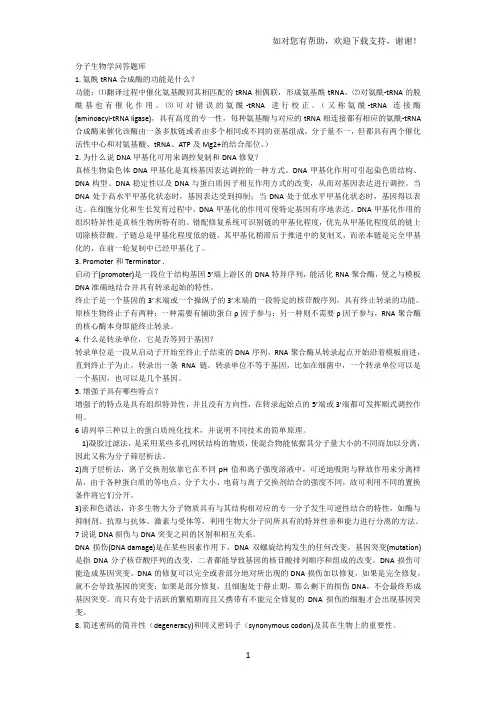
分子生物学问答题库1. 氨酰tRNA合成酶的功能是什么?功能:⑴翻译过程中催化氨基酸同其相匹配的tRNA相偶联,形成氨基酰tRNA。
⑵对氨酰-tRNA的脱酰基也有催化作用。
⑶可对错误的氨酰-tRNA进行校正。
(又称氨酰-tRNA连接酶(aminoacyl-tRNA ligase),具有高度的专一性,每种氨基酸与对应的tRNA相连接都有相应的氨酰-tRNA 合成酶来催化该酶由一条多肽链或者由多个相同或不同的亚基组成,分子量不一,但都具有两个催化活性中心和对氨基酸、tRNA、ATP及Mg2+的结合部位。
)2. 为什么说DNA甲基化可用来调控复制和DNA修复?真核生物染色体DNA甲基化是真核基因表达调控的一种方式。
DNA甲基化作用可引起染色质结构、DNA构型、DNA稳定性以及DNA与蛋白质因子相互作用方式的改变,从而对基因表达进行调控。
当DNA处于高水平甲基化状态时,基因表达受到抑制;当DNA处于低水平甲基化状态时,基因得以表达。
在细胞分化和生长发育过程中,DNA甲基化的作用可使特定基因有序地表达。
DNA甲基化作用的组织特异性是真核生物所特有的。
错配修复系统可识别链的甲基化程度,优先从甲基化程度低的链上切除核苷酸。
子链总是甲基化程度低的链,其甲基化稍滞后于推进中的复制叉,而亲本链是完全甲基化的,在前一轮复制中已经甲基化了。
3. Promoter和Terminator .启动子(promoter)是一段位于结构基因5’端上游区的DNA特异序列,能活化RNA聚合酶,使之与模板DNA准确地结合并具有转录起始的特性。
终止子是一个基因的3’末端或一个操纵子的3’末端的一段特定的核苷酸序列,具有终止转录的功能。
原核生物终止子有两种:一种需要有辅助蛋白ρ因子参与;另一种则不需要ρ因子参与,RNA聚合酶的核心酶本身即能终止转录。
4. 什么是转录单位,它是否等同于基因?转录单位是一段从启动子开始至终止子结束的DNA序列,RNA聚合酶从转录起点开始沿着模板前进,直到终止子为止,转录出一条RNA链。
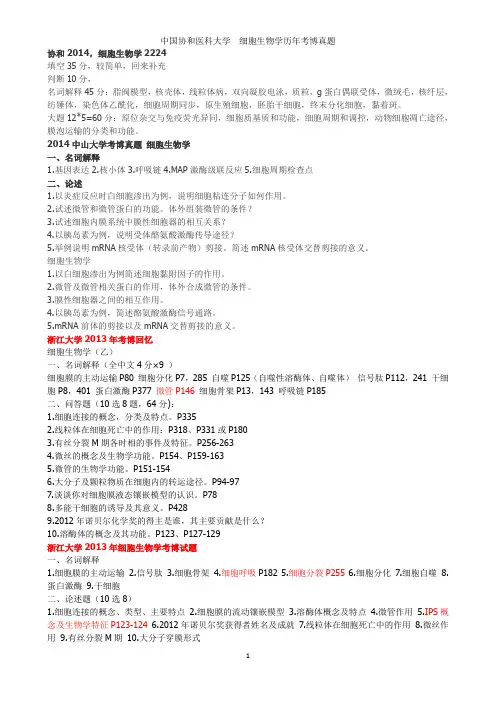
协和2014,细胞生物学2224填空35分,较简单,回来补充判断10分,名词解释45分:脂阀模型,核壳体,线粒体病,双向凝胶电泳,质粒,g蛋白偶联受体,微绒毛,核纤层,纺锤体,染色体乙酰化,细胞周期同步,原生殖细胞,胚胎干细胞,终末分化细胞,黏着斑。
大题12*5=60分:原位杂交与免疫荧光异同,细胞质基质和功能,细胞周期和调控,动物细胞凋亡途径,膜泡运输的分类和功能。
2014中山大学考博真题细胞生物学一、名词解释1.基因表达2.核小体3.呼吸链4.MAP激酶级联反应5.细胞周期检查点二、论述1.以炎症反应时白细胞渗出为例,说明细胞粘连分子如何作用。
2.试述微管和微管蛋白的功能。
体外组装微管的条件?3.试述细胞内膜系统中膜性细胞器的相互关系?4.以胰岛素为例,说明受体酪氨酸激酶传导途径?5.举例说明mRNA核受体(转录前产物)剪接。
简述mRNA核受体交替剪接的意义。
细胞生物学1.以白细胞渗出为例简述细胞黏附因子的作用。
2.微管及微管相关蛋白的作用,体外合成微管的条件。
3.膜性细胞器之间的相互作用。
4.以胰岛素为例,简述酪氨酸激酶信号通路。
5.mRNA前体的剪接以及mRNA交替剪接的意义。
浙江大学2013年考博回忆细胞生物学(乙)一、名词解释(全中文4分×9 )细胞膜的主动运输P80 细胞分化P7,285 自噬P125(自噬性溶酶体、自噬体)信号肽P112,241 干细胞P8,401 蛋白激酶P377 微管P146 细胞骨架P13,143 呼吸链P185二、问答题(10选8题,64分):1.细胞连接的概念,分类及特点。
P3352.线粒体在细胞死亡中的作用:P318、P331或P1803.有丝分裂M期各时相的事件及特征。
P256-2634.微丝的概念及生物学功能。
P154、P159-1635.微管的生物学功能。
P151-1546.大分子及颗粒物质在细胞内的转运途径。
P94-977.谈谈你对细胞膜液态镶嵌模型的认识。

目录四川大学华西医学部博士入学考试口腔内科试题 (2)2004年 (2)四川大学华西医学部病理学博士入学考试试题 (2)2006年 (2)四川大学华西医学部骨科专业博士入学考试试题 (3)2004年 (3)2004年 (4)四川大学华西医学部博士入学考试口腔内科试题2004年1.牙髓牙本质复合体2.根尖基点3.牙龈素4.副肿瘤性天疱疮5.显著性龋均指数1.牙菌斑是如何致龋的2.根管治疗的进展3.控制牙菌斑对牙周炎治疗的意义及控制方法4.复发性口疮为什么可以用免疫抑制剂,也可以用免疫增强剂,举例说明5.根据自己的知识讲述中国口腔疾病的现状,并提出防治策略及方法四川大学华西医学部病理学博士入学考试试题2006年四川大学华西医学部骨科专业博士入学考试试题2004年一、名词解释:(每题2分)Tissue engineeringColles’ fractureBone-fascia compartment syndromeGaleazzi’s fractureThomas sign二、问答题:⒈上下肢骨传导音的检查方法及意义?⒉股骨头血供的特点及其对股骨颈骨折的临床治疗、预后的指导意义?⒊脊柱“三柱”理论的原理及其对脊柱骨折治疗的指导意义?请简述脊柱骨折治疗的基本原则?⒋人工髋关节置换术后骨溶解的病理生理及临床表现?目前有效的治疗方法?⒌骨关节结核与慢性骨关节化脓性感染的异同?请简述两者治疗方法的特点?⒍病案分析男性,30岁,伤后8小时入院,双下肢活动障碍,双骶髂关节部肿胀疼痛。
X 光片下示耻骨联合分离3Cm,双侧骶髂关节脱位,骶骨骨折。
请给出治疗方案并说明理由。
四川大学华西医学部局解(骨科专业基础)博士入学考试试题2004年每题10分,选做100分⒈脊椎骨间的主要连接?⒉股鞘的结构与内容?⒊阑尾的常见位置,怎样寻找阑尾?⒋腹股沟管的构成?⒌甲状腺的位置、毗邻、甲状腺血管与神经的关系?⒍胸膜腔的体表投影?⒎子宫的位置及毗邻?⒏直肠的形态和毗邻?⒐心脏的血供?⒑肝外胆管的组成及毗邻?⒒后纵隔的结构及排列关系?⒓肾脏的位置与毗邻?⒔会阴中心体的构成及作用?⒕女性乳房的结构特点及主要淋巴引流?。
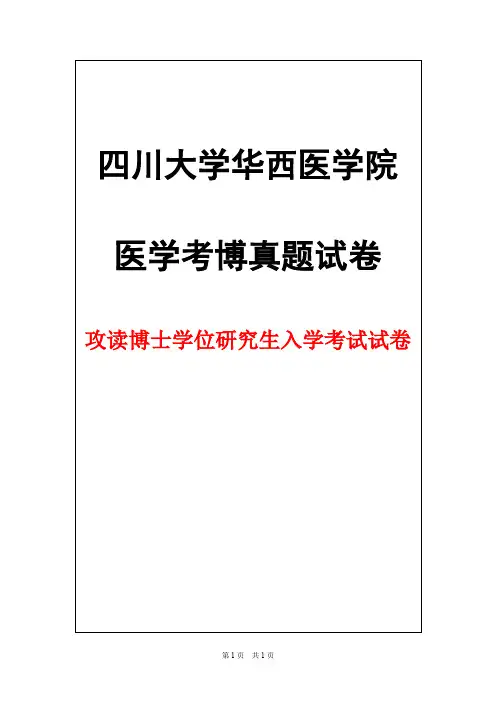
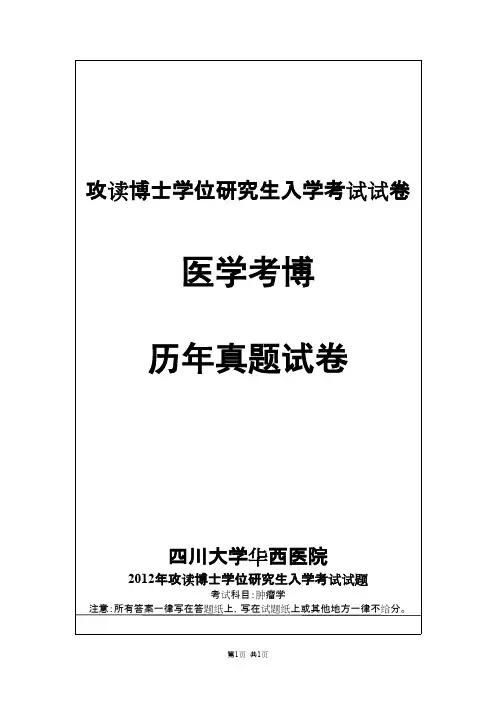

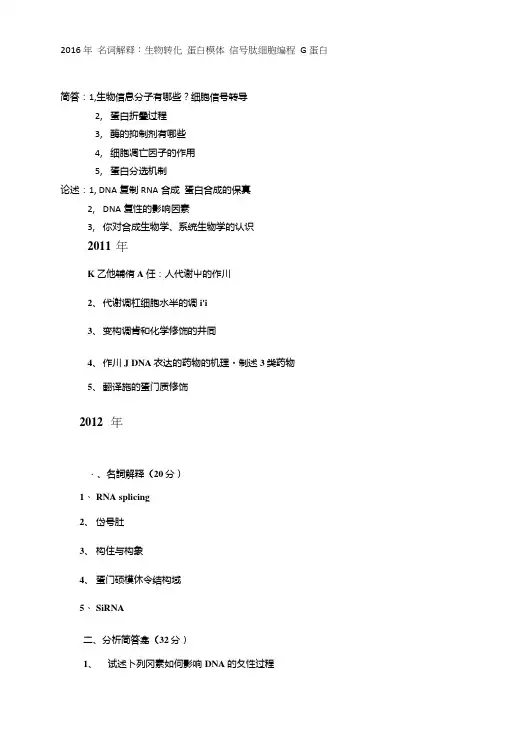
2016 年名词解释:生物转化蛋白模体信号肽细胞编程G蛋白简答:1,生物信息分子有哪些?细胞信号转导2,蛋白折叠过程3,酶的抑制剂有哪些4,细胞凋亡因子的作用5,蛋白分选机制论述:1, DNA复制RNA合成蛋白合成的保真2,DNA复性的影响因素3,你对合成生物学、系统生物学的认识2011年K乙他辅侑A任:人代谢屮的作川2、代谢调杠细胞水半的调i'i3、变构调肯和化学修饰的井同4、作川J DNA衣达的药物的机理•制述3类药物5、翻译施的蛋门质修饰2012年・、名詞解释(20分)1、RNA splicing2、岱号肚3、构住与构象4、蛋门硕模休令结构域5、SiRNA二、分析简答龛(32分)1、试述卜列冈素如何影响DNA的夂性过程<1)RIW ((2)低J * Tm 度(3〉高浓度的DNA 链2、«A»U冰的原理及其应川3>匝嘤细胞Mi'rW fYf哪叫?兀作川机制如何?4、仆•种混介液MA、B、C -种蛋m 这二种蛋门分了;1匕等电点如卜:A1M000,8.5; B 64000 , 5.9 : C 6000・6.0按分/讹和竽电点将J〔分肉纯化这三种蛋仏并列:||签定方汰.二论述題(48分)K DNA M制、RNA介成、蛋门质介成如何保证冀保戊性?2、细胞内们号传导及冀作川机制3、运川化物化学用I关掠理说明药物介理设讣2013年・、名诃解释(20分)K信号从2.诵导肚3.模休4.Gutn5 •转化二简签越1.DNA M制、转录和胡译如何保允2.什么朋抑制剂?简述右哪儿种抑制剂.分别冇什么待点?3・细胞倍号转导7、论述鬆K细胞核编码的蛋门的分选途径?2、Flftl 7个冈素足怎么影响DNA变性的,高浓度阳离仇低Tmffi, ft浓度的DNA ?3、列;I;朗个实鲨分肉纯化乐门.并说岀原理.蛋门分fWflPI分别为64000、8.0;18000、5.91 6000 . 6.0.2014 年・、名词解释1、RNA splicing2、Apoptosis3、Instructs enzyme4、Stemp cell engering5、Systemic biology二、简答悪K 例举关「2013年保学或生理学方Ifil91尔并说期冀上嘤内容及门<2 的见解2、DNA V兴的彩响W^:(l)Blwr浓度(2)隘度Tm (3)DNA 浓度3、un^t的比沾性测足\论述理1、H«;素与碳胺类药物的作用机制?2、允核生物与原核生物转杀麻的加I:Y J H井同?3、对r儿种人匸合成底物1刑一酶《i结介时•侑9底物納介的亲和力人小不同・怎样说明?2015 年仁名诃解释(40)K端粒(酶)2、两性a •螺旋3、G PCR4、G WAS5、磷酸无糖途径6、氏链II编码RNA7、朋体8、化学注透学说9、R NAi10、Ubiquitination1、扎糖操纵/和色奴酸操纵/的调控作川2、苏门质结构与功能的关系3、信号转9途径井常9疾病发僅的关系.并设讣种町能的I•扰FBI4、描述〔种不同的组学研丸方法及其任医药学中的嗣IJ5、匕醸辅侑A任物质代谢屮的匝耍作川6、•般1何二DNA损伤对生物体祁是冇害的・”!实质上也右右益的•仏即DNAftl伤仆双咆效应,你如何解释这•观点•。
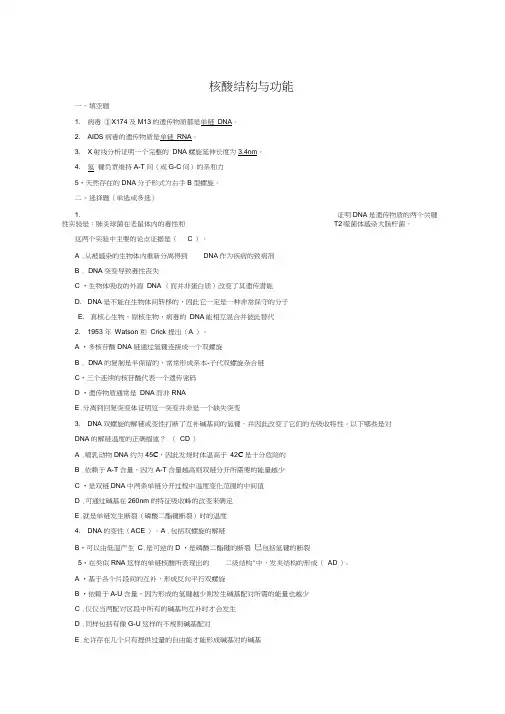
核酸结构与功能一、填空题1. 病毒①X174及M13的遗传物质都是单链DNA。
2. AIDS病毒的遗传物质是单链RNA。
3. X射线分析证明一个完整的DNA螺旋延伸长度为3.4nm。
4. 氢键负责维持A-T间(或G-C间)的亲和力5•天然存在的DNA分子形式为右手B型螺旋。
二、选择题(单选或多选)1. 证明DNA是遗传物质的两个关键性实验是:肺炎球菌在老鼠体内的毒性和T2噬菌体感染大肠杆菌。
这两个实验中主要的论点证据是( C )。
A .从被感染的生物体内重新分离得到DNA作为疾病的致病剂B . DNA突变导致毒性丧失C •生物体吸收的外源DNA (而并非蛋白质)改变了其遗传潜能D. DNA是不能在生物体间转移的,因此它一定是一种非常保守的分子E. 真核心生物、原核生物、病毒的DNA能相互混合并彼此替代2. 1953 年Watson 和Crick 提出(A )。
A •多核苷酸DNA链通过氢键连接成一个双螺旋B . DNA的复制是半保留的,常常形成亲本-子代双螺旋杂合链C•三个连续的核苷酸代表一个遗传密码D •遗传物质通常是DNA而非RNAE.分离到回复突变体证明这一突变并非是一个缺失突变3. DNA双螺旋的解链或变性打断了互补碱基间的氢键,并因此改变了它们的光吸收特性。
以下哪些是对DNA的解链温度的正确描述?(CD )A .哺乳动物DNA约为45C,因此发烧时体温高于42C是十分危险的B .依赖于A-T含量,因为A-T含量越高则双链分开所需要的能量越少C •是双链DNA中两条单链分开过程中温度变化范围的中间值D .可通过碱基在260nm的特征吸收峰的改变来确定E.就是单链发生断裂(磷酸二酯键断裂)时的温度4. DNA的变性(ACE )。
A .包括双螺旋的解链B•可以由低温产生C.是可逆的D •是磷酸二酯键的断裂巳包括氢键的断裂5•在类似RNA这样的单链核酸所表现岀的二级结构"中,发夹结构的形成(AD )oA •基于各个片段间的互补,形成反向平行双螺旋B •依赖于A-U含量,因为形成的氢键越少则发生碱基配对所需的能量也越少C .仅仅当两配对区段中所有的碱基均互补时才会发生D .同样包括有像G-U这样的不规则碱基配对E.允许存在几个只有提供过量的自由能才能形成碱基对的碱基6. DNA分子中的超螺旋(ACE )A 仅发生于环状DNA 中。
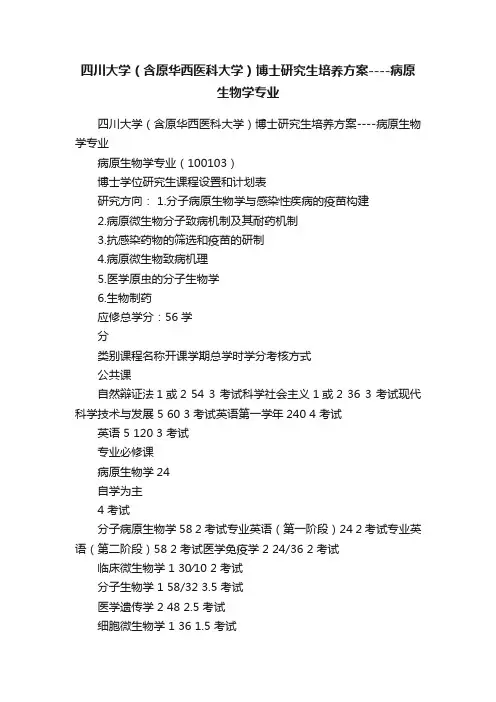
四川大学(含原华西医科大学)博士研究生培养方案----病原生物学专业四川大学(含原华西医科大学)博士研究生培养方案----病原生物学专业病原生物学专业(100103)博士学位研究生课程设置和计划表研究方向: 1.分子病原生物学与感染性疾病的疫苗构建2.病原微生物分子致病机制及其耐药机制3.抗感染药物的筛选和疫苗的研制4.病原微生物致病机理5.医学原虫的分子生物学6.生物制药应修总学分:56学分类别课程名称开课学期总学时学分考核方式公共课自然辩证法1或2 54 3 考试科学社会主义1或2 36 3 考试现代科学技术与发展 5 60 3 考试英语第一学年240 4 考试英语 5 120 3 考试专业必修课病原生物学24自学为主4 考试分子病原生物学58 2 考试专业英语(第一阶段)24 2 考试专业英语(第二阶段)58 2 考试医学免疫学 2 24/36 2 考试临床微生物学1 30∕10 2 考试分子生物学 1 58/32 3.5 考试医学遗传学 2 48 2.5 考试细胞微生物学 1 36 1.5 考试细胞生物学24 60 3 考试病原生物学进展58 自学 2 文献综述分子细菌学实验技术58 自学 2 文献综述感染性疾病疫苗研究进展58 自学2 文献综述细菌耐药性机制58 自学 2 文献综述选修课医学统计学 2 35/35 2 考查医学文献检索与应用 1 20/40 1 考查核酸及分子克隆技术 2 0/48 1 考查蛋白质与酶分离纯化技术 2 0/48 1 考查基因治疗基础与临床2 15∕10 1 考查实验动物学基础 1 30/0 1 考查知识产权及保护 1 15 1 考查心理学 1 25 1 考查学术交流活参加不少于12次,其中本人作学术报告不少于2次 2 动。
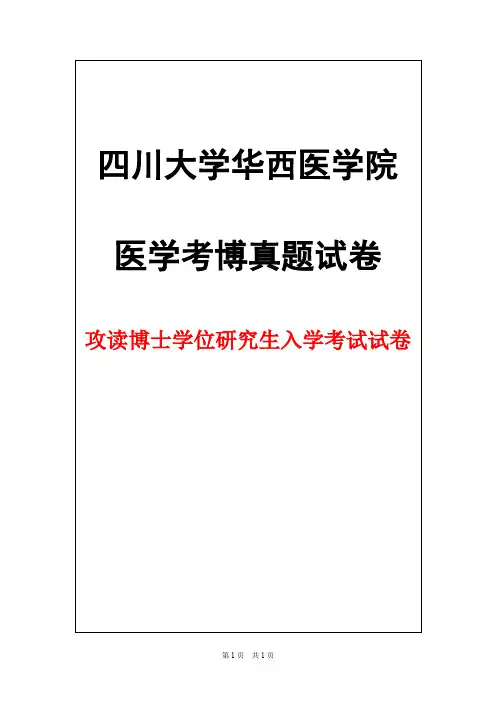
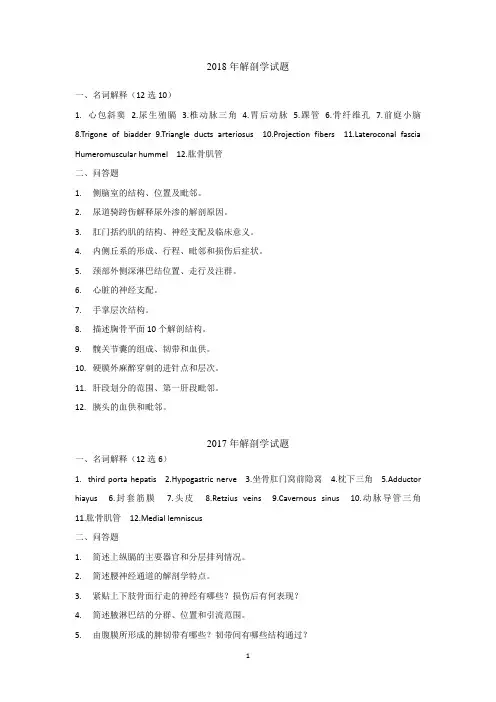
2018年解剖学试题一、名词解释(12选10)1.心包斜窦2.尿生殖膈3.椎动脉三角4.胃后动脉5.踝管6.骨纤维孔7.前庭小脑8.Trigone of biadder9.Triangle ducts arteriosus 10.Projection fibers teroconal fascia Humeromuscular hummel 12.肱骨肌管二、问答题1.侧脑室的结构、位置及毗邻。
2.尿道骑跨伤解释尿外渗的解剖原因。
3.肛门括约肌的结构、神经支配及临床意义。
4.内侧丘系的形成、行程、毗邻和损伤后症状。
5.颈部外侧深淋巴结位置、走行及注群。
6.心脏的神经支配。
7.手掌层次结构。
8.描述胸骨平面10个解剖结构。
9.髋关节囊的组成、韧带和血供。
10.硬膜外麻醉穿刺的进针点和层次。
11.肝段划分的范围、第一肝段毗邻。
12.胰头的血供和毗邻。
2017年解剖学试题一、名词解释(12选6)1.third porta hepatis2.Hypogastric nerve3.坐骨肛门窝前隐窝4.枕下三角5.Adductor hiayus6.封套筋膜7.头皮8.Retzius veins9.Cavernous sinus 10.动脉导管三角11.肱骨肌管12.Medial lemniscus二、问答题1.简述上纵膈的主要器官和分层排列情况。
2.简述腰神经通道的解剖学特点。
3.紧贴上下肢骨面行走的神经有哪些?损伤后有何表现?4.简述腋淋巴结的分群、位置和引流范围。
5.由腹膜所形成的脾韧带有哪些?韧带间有哪些结构通过?6.十二指肠的走行、分布、第三段毗邻关系。
7.肾旁前间隙的周界、内容和临床意义。
8.在正常前倾屈位下子宫各部的毗邻。
9.直肠的结构特点和血供。
10.腹壁浅筋膜性层附着及该积血区的通连(有图)。
11.内囊结构、通行结构(上下行投射纤维及名称)、血供及损伤后的临床表现。
12.描述颈部血供情况(颈内、外总动脉的位置、走行及分支情况,重点描述颈外动脉及动脉分支及甲状腺血供)。
考博详解与指导局部解剖学:一、名词解释:颈动脉窦,肺根,面部危险三角区,膀胱直肠陷凹,胆囊三角,(还有一个想不起了)二、问答题:(9选7)1.临床作气管切开的位置,经过的层次,切开过深可损伤的器官,过低可造成什么后果2.盆腹部消化管道的动脉血供及来源3.上、下腔静脉系的吻合支4.腹部器官、结构的体表投影(至少10个)5.子宫的位置,及影响其位置的因素6.股三角的内容、排列及交通7.腮腺肿大可压迫那些结构8.颈根部的结构9.左右纵隔之间的血管、神经名称及位置病理真题1,名词解释:肉芽组织,老化,autopsy,瘘管,转移钙化,紫癜,类白血病反应,肺褐色硬化,纤维素样坏死2,选择题:老样子很简单3,简答体:肿瘤增生和非肿瘤增生的区别。
病案讨论:冠心病及其合并症有关的。
为什么说淤血总是病理性的?说出3种胃肠道的肉芽肿性炎。
说出3种病理诊断方法及其特点。
肿瘤的TNM分期,举例1个第一部分、传统面试问题(Sample Traditional Interview Questions)1、What can you tell me about yourself?(关于你自己,你能告诉我些什么?)这一问题如果面试没有安排自我介绍的时间的话。
这是一个必问的问题。
考官并不希望你大谈你的个人历史,他是在寻找有关你性格、资历、志向和生活动力的线索,来判断你是否适合读研或者MBA。
下面是一个积极正面回答的好例子:“在高中我参加各种竞争性体育活动,并一直努力提高各项运动的成绩。
大学期间,我曾在一家服装店打工,我发现我能轻而易举地将东西推销出去。
销售固然重要,但对我来说,更重要的是要确信顾客能够满意。
不久便有顾客返回那家服装店点名让我为他们服务。
我很有竞争意识,力求完美对我很重要。
”In high school I was involved in competitive sports and I always tried to improve in each sport I participated in.As a college student,I worked in a clothing store part-time and found that I could sell things easily.The sale was important,but for me,it was even more important to make sure that the customer was satisfied.It was not long before customers came back to the store and specifically asked for me to help them.I’m very competitive and it means a lot to me to be the best.2、What would you like to be doing five years after graduation?(在毕业以后5年内你想做些什么?)你要清楚你实际上能胜任什么。
四、论述1.桡骨远端骨折的诊断,治疗进展,对手术和非手术治疗的理解。
桡骨远端骨折根据病史、临床症状、体征及X线检查可作出诊断。
根据受伤机制可分为伸直型骨折、屈曲型骨折、关节面骨折伴腕关节脱位,伸直型骨折主要以手法复位外固定治疗为主,部分需要手术治疗,指征:1、严重粉碎骨折移位明显,桡骨下端关节面破坏2、手法复位失败,或复位成功,外固定不能维持复位。
屈曲型骨折主要采用手法复位,夹板或石膏固定。
复位手法与伸直型骨折相反,基本原则相同。
复位后若极不稳定,外固定不能维持复位者,行切开复位或内固定。
桡骨远端关节面骨折伴腕关节脱位是桡骨远端骨折的一种特殊类型临床上常漏诊或错误诊断为腕关节脱位。
只要仔细阅读X线片,诊断并不困难,治疗首先采用手法复位、夹板石膏外固定方法治疗。
复位后很不稳定者,可切开复位,钢针内固定。
2.股骨转子间骨折的髓内和髓外固定的选择。
滑动髋螺钉在术中股骨骨折、术后股骨骨折、内固定切出风险、再手术风险、随访期内残留髋部或大腿疼痛方面明显优于Gamma钉,与股骨近端髓内钉相当。
对于稳定型股骨转子间骨折,髓内和髓外固定均可获得满意的疗效。
使用动髋螺钉固定不仅整体稳定性较好,而且操作简单、低成本,并发症也更少,有学者认为动力髋螺钉是治疗稳定性转子间骨折的最好选择。
随着2孔和3孔动力髋螺钉的应用,髓外固定同样可做到小切口微创置入,另外髓外固定对于不稳定转子间骨折及反转子间骨折,多数学者认为髓内系统优于髓外固定系统,应选择股骨近端髓内钉或股骨近端抗旋髓内钉等髓内固定系统进行固定。
股骨近端髓内钉和股骨近端抗旋髓内钉等髓内固定系统不仅创伤小,而且允许患者固定后早期负重,减少固定后并发症,是治疗不稳定型股骨近端骨折的理想选择。
髓内固定系统治疗转子间骨折是近年来研究热点,2004年初推出的Gamma3在第一代Gamma钉的基础上改良而成,可以根据不同的骨折类型,选择动态加压、静态加压、静态支撑,以达到最好的固定效果,适用于各型股骨转子间骨折。
08中科院分子生物学试题1、表观遗传,及调控方式,还有蛋白质通过哪些共价修饰调控其功能?2、蛋白质与DNA结合的方法和比较,EMSA和DNase1足迹法?3、密码子改造研究新蛋白药物,原理,关键和方法4、设计研究未知基因(预测两个跨膜区域)功能的实验方案(不低于4个)5、质粒改造原则6、诱导全能干细胞的方法,实验方案等。
(去年的nature上发表的)个人认为除了第二和五题之外,其它的题目都属于一骑绝尘的,要么会,要么不会,想蒙是绝对没门的。
这门专业课能及格,我想都不错了,特别是1,3,6题。
不知道大家做的如何,反正第一题,我是意思都没看懂,不知道连续的3问是不是指1个东西。
还是最后1问是单独的,与前面的2问无关2008年中科院动物所生物化学与分子生物学博士题一名词解释密码子的变偶性程序性死亡冈崎片断单克隆抗体基因治疗 SD序列移码突变 Z型DNA 蛋白质组学反向PCR二大题简述真核生物5’帽子结构和功能。
简述NO作为信号分子的调节作用。
运用你所学的知识和可能的实验经验,研究一个新基因的生理功能。
已知A和B蛋白质作用于同一生理功能,至少用三种方法证明A和B之间有无相互作用,并给出所用原理。
结合当前科学前沿,阐述真核生物基因表达调控。
2008年浙江大学分子生物学考博试题问答题:双向电泳的原理及应用三种分子标记方法描述两种大规模研究DNA的方法2007年诺贝尔生理与医学奖授予什么技术,该技术的应用人类基因组中有一基因为2Kb,提到的基因组为10微克,计算该基因的含量名词解释:免疫沉淀,RNA剪切,核糖开关,分子伴侣,浙江大学2006秋博分子生物学考题分子生物学(甲)名词解释(每个4分)原位杂交、顺式作用元件、信号肽、选择性剪接、C-值矛盾(c-value paradox)问答题(每个20分)1、RNAi的优缺点,如何避免改正2、何为正向遗传学、反向遗传学,阐述一条反向遗传学研究功能基因的方法3、真核生物基因表达调控的途径4、近年分子生物学中诺贝尔奖有哪些,请举二例,说明内容和意义2008年华中科技大学生化与分子考试试题生化与分子共七道题:1. 蛋白质的结构原则2. 进化中为什么选择蛋白和RNA作为酶3.关于盐浓度对蛋白与DNA结合能力的影响(具体的题太长,叙述难免出错,所有把考点给出来大家斟酌)4.基因功能的研究方法,简述3类及原理5.真核与原核细胞的启动子的结构和功能及翻译起始的差异与共同点6.关于基因CDNA克隆和蛋白表达的方法的实验设计题!有一植物中共有的基因与某重要功能有关。
2018 年全国医学博士英语统一考试试题试卷一 (Paper One)Part I Listening Comprehension (30%)Section ADirections: In this section you will hear fifteen short conversations between two speakers. At the end of each conversation, you will hear a question about what is said. The question will be read only once, after you hear the question, read the four possible answers marked A, B, C and D. Choose the best answers and mark the letter of your choice on the ANSWER SHEET.Listen to the following example.You will hear:Woman: I feel faint.Man: No wonder You haven’t had a bite all day.Question: What’s the matter with the woman?You will read:A. She is sick.B. She is bitten by an ant.C. She is hungry.D. She spilled her paint.Here C is the right answer.Sample AnswerA B ● D Now let’s begin with question Number 1.1. A. On campus B. At he dentist’sC.At the pharmacyD. In the laboratory2. A. Pain B. Weakness C. Fatigue D. Headache3. A. Their weird behavior at school.B. Their superior cleverness over others’.C. Their tendency to have learning difficulty.D. Their reluctance to switch to right handedness.4. A. John will be angry. B. John will be disappointed.C. John will be attracted.D. John will be frightened.5. A. Th ey’re quite normal. B. They’re not available.C. They came unexpected.D. They need further explanation.6. A. He knows so little about Lady GagaB. He has met Lady Gaga before.C. He should have known Lady GagaD. He is a big fan of Lady Gaga.C. In the emergency room.D. On their way to the hospital8. A. Health care B. Health reformC. Health educationD. Health maintenance9. A. Learning to act intuitively.B. Learning to argue academically.C. Learning to be critical of oneself.D. Learning to think critically and reason10. A. She is a pharmacist. B. She is a medical doctor.C. She is a scientist in robotics.D. She is a pharmacologist.11. A. She’s pessimistic about the future.B. She’s pessimistic about the far future.C. She’s optimistic about the far future.D. She’s optimistic about the near future.12. A. Negligence may put a patient in danger.B. Patients must listen to doctors and nurses.C. Qualified doctors and nurses are in bad need.D. Patients should be careful about choosing the right hospital.13. A. The man works at eh ER.B. The man can do nothing but wait.C. The woman’s condition is critical.D. The woman is a capable paramedic.14. A. A gynecologist. B. A psychologistC. A neurologist.D. A nephrologist.15. A. She has only one friend.B. She isolates herself from others.C. She suffers from a chronic disease.D. She is jobless and can’t find a job.Section BDirections: In this section you will hear one conversation and two passages, after each of which, you will hear five questions. After each question, read the four possible answers marked A, B, C and D. Choose the best answer and mark the letter of your choice on the ANSWER SHEET.DialogueQuestions 16-20 are based on the following dialogue.16. A. Because she couldn’t do other jobs well.B. Because it was her dream since childhood.C. Because she was fed up with all her previous jobs.D. Because two professors found talent in her and inspired her to do it.17. A. The Self/Nonself Model B. The Danger ModelC. The vaccination theoryD. The immunological theory18. A. Being overactive B. Being mutantC. Being selectiveD. Being resistant19. A. It can help cure most cancers.B. It can help develop new drugs.C. It can help most genetic diseases.D. It can help change the nature of medicine.20. A. We should ignore the resistance.B. We should have the model improved.C. We should have the experiments on animals.D. We should move from animals to human.Passage One21. A. The profits form medical tourism.B.The trendy phenomenon of medical tourism.C.The soaring health care costs around the word.D.The steps to take in developing medical tourism22. A. Affordable costs B. Low pace of livingC. Five-star treatmentD. Enjoyable health vacation23. A. It is a$100 billion business already.B. It is growing along with medical tourism.C. Its costs are skyrocketing with medical tourism.D. It offers more medical options than western medicine.24. A. To set up a website for blogging about medical tourism.B. To modify our lifestyles and health behaviors.C. To buy and affordable medical insurance.D. To explore online to get well informed.25. A. A travel brochure.B. A lecture on medical tourism.C. A chapter of a medical textbook.D. A webpage promotional material.Passage TwoQuestions 26-30 are based on the following passage.26. A. Song sparrows take good care of their babies.B. Young song sparrows back the skills and experience of their parents.C. There are different kind of song sparrows in different seasons.D. Young and old song sparrows experience climate change different.27. A. In the warmer spring B. In the hottest summerC. In the coolest autumnD. In the coldest winter28. A. Because they lack the skill and experience to find food.B. Because they have not developed a strong body yet.C. Because they cannot endure the unusual heat.D. Because they cannot find enough food.29. A. They are less sensitive to the effect of climate change thanks to their parents.B. They are quick to develop strong bodies to encounter climate change.C. They experience food insufficiency due to climate change.D. They are as sensitive to climate change as the juveniles.30. A. Body size B. Migration routeC. Food preferenceD. Population growthPart Ⅱ Vocabulary (10%)Section ADirections: In this section, all the sentences are incomplete. Four words or phrases marked A, B, C and D are given beneath each of them. You are to choose the word or phrase that best completes the sentence, then mark your answer on the ANSWER SHEET.31.The medical team discussed their shared ____to eliminating this curable disease.A.obedienceB. susceptibilityC. inclinationD. dedication32. Many of us are taught from an early age that the grown-up response to pain, weakness, oremotional_____is to ignore it, to tough it out.A. TurmoilB. rebellionC. temptationD. relaxation33. Those depressed kids seem to care little about others,____communication and indulge in theirown worlds.A. put downB. shut downC. settle downD. break down34. The school board attached great emphasis to____ in students a sense of modesty and a sense ofcommunity.A. dilutingB. inspectingC. instillingD. disillusioning35. Our brain is very good at filtering out sensory information that is not______to what we need tobe attending to.A. pertinentB. permanentC. precedentD. prominent36. New studies have found a rather____correlation between the presence of small particles andboth obesity and diabetes.A. collaboratingB. comprehendingC. compromisingD. convincing37. We must test our____about what to include in the emulation and at what level at detail.A. intelligenceB. imitationsC. hypothesisD. precautions.38. We must____the problem____, which is why our map combines both brain structure andfunction measurements at large scale and high resolution.A. set...backB. take...overC. pull...inD. break...down39. Asthma patient doesn’t need continuous treatment because his symptoms are rather____thanpersistent.A. intermittentB. precedentC. dominantD. prevalent40. It is simply a fantastic imagination to_____that one can master a foreign language overnight.A. conceiveB. concealC. convertD. conform Section BDirections: Each of the following sentences has a word or phrase underlined. There are four words or phrases beneath each sentence. Choose the word or phrase which can best keep the meaning of the original sentence if it is substituted for the underlined part. Mark your answer on the ANSWER SHEET.41. The truly competent physician is the one who sits down, senses the “mystery”of anotherhuman beings, and often the simple gifts of personal interest and understanding.A. imaginableB. capableC. sensibleD. humble42. The physician often perceived that treatment was initiated by the patient.A. conservedB. theorizedC. realizedD. persisted43. Large community meals might have served to lubricate social connections and alleviatedtensions.A. facilitateB. intimidateC. terminateD. mediate44. Catalase activity reduced glutathione and Vitamin E levels were decreased exclusively insubjects with active disease.A. definitelyB. trulyC. simplyD. solely45. Ocular anomalies were frequently observed in this cohort of offspring born after in vitrofertilization.A. FetusesB. descendantsC. seedsD. orphans46. Childhood poverty should be regarded as the single greatest public health menace facing ourchildren.A. breachB. griefC. threatD. abuse47. A distant dream would be to deliberately set off quakes to release tectonic stress in a controlledway.A. definitelyB. desperatelyC. intentionallyD. identically48. Big challenges still await companies converting carbon dioxide to petrol.A. applyingB. relatingC. relayingD. transforming49. Concern have recently been voiced that the drugs elicit unexpected cognitive side effects, suchas memory loss, fuzzy thinking and learning difficulties.A. ensueB. encounterC. impedeD. induce50. A leaf before the eye shuts out Mount Tai, which means having one’s view of the importantovershadowed by the trivial.A. insignificantB. insufficientC. substantialD. unexpectedPart ⅢCloze (10%)Directions: In this section there is a passage with ten numbered blanks. For each blank, there are four choices marked A, B, C and D on the right side. Choose the best answer and mark the letter of yourchoice on the ANSWER SHEIET.The same benefits and drawbacks are found when using CT scanning to detect lung cancer—the three-dimensional imaging, improve detection of disease but creates hundreds of images that increase a radiologist’s workload, which, 51 , can result in missed positive scans.Researchers at University of Chicago Pritizker School of Medicine presented 52 data on a CAD (computer-aided diagnosis) program they’ve designed that helps radiologist spot lung cancer 53 CT scanning. Their study was 54 by the NIH and the university.In the study, CAD was applied to 32 low-dose CT scanning with a total of 50 lung nodules, 38 of which were biopsy-confirmed lung cancer that were not found during initial clinical exam. 55 the 38 missed cancers,15 were the result of interpretation error (identifying an image but 56 it as non cancerous) and 23 57 observational error(not identifying the cancerous image).CAD found 32 of the 38 previously missed cancers (84% sensitivity), with false-positive 58 of 1.6 per section.Although CAD improved detection of lung ca ncer, it won’t replace radiologists, said Sgmuel G Armato, PhD, lead author of the study.” The computer is not perfect,”Armato said.” It will miss some cancers and call some things cancer that 59 . The radiologists can identify normal anatomy that the computer may 60 something suspicious. It’s a spell-checker of sorts, or a second opinion.51.A. in common B. in turn C. in one D. in all52.A. preliminary B. considerate C. deliberate D. ordinary53.A. being used B. to use C. using D. use54.A. investigated B. originated C. founded D. funded55.A. From B. Amid C. Of D. In56.A. disseminating B. degenerating C. dismissing D. deceiving57.A. were mistaken for B. were attributed to C. result in D. gave away to58.A. mortalities B. incidences C. images D. rates59.A. don’t B. won’t C. aren’t D. wasn’t60.A. stand for B. search for C. account for D. mistake forPart Ⅳ Reading Comprehension (30%)Directions: In this part there are six passages, each of which is followed by five questions. For each question there are four possible answers marked A, B, C and D. Choose the best answer and mark the letter of your choice on the ANSWER SHEET.Passage OneWhen Tony Wagner, the Harvard education specialist, describes his job today, he says he’s“a translator between two hostile tribes”—the education world and the business world, the people who teach our kids and the people who give them jobs. Wagner’s ar gument in his book “Creating Innovations: The Making of Young People Who Wil l Change the World” is that our K-12 and college tracks are not consistently “adding the value and teaching the skills that matter most in themarketplace.”This is dangerous at a time when there is increasingly to such things as a high-wage, middle-skilled job—the thing that sustained the middle class in the last generation. Now, there is only a high-wage, high-skilled job. Every middle-class job today is being pulled up, out or down faster than ever. That is, it either requires more skill or can be done by more people around the world or is being buried made obsolete faster than ever. Which is why the goal of education today, argues Wagner, should not be to make every child “college ready” but “innovation ready”—ready to add value to whatever they do.That is a tall task. I tracked Wagner down and asked him to elaborate. “Today,” he said via e-mail,” because knowledge is available on every Internet-connected device, what you know matters far less than what you can do with what you know. The capacity to innovate—the ability to solve problems creatively or bring new possibilities to life and skills like critical thinking,communication and collaboration are far more important than acade mic knowledge. As one executive told me, “We can teach new hires the content. And we will have to because it continues to change, but we can’t teach them how to think—to ask the right questions—and to take initiative.”My generation had it easy. We got to “find” a job. But, more than ever, our kids will have to “invent” a job. Sure, the lucky ones will find their first job, but, given the pace of change today, even they will have to reinvent, re-engineer and reimagine that job much often than their parents if they want to advance in it.“Finland is one of the most innovative economics in the world,”Wagner said,” and it is the only country where students leave high school ‘innovation-ready.’ They lea rn concepts and creativity more than facts, and have a choice of many elective—all with a shorter school day, little homework, and almost no testing. There are a growing number of “reinvented”colleges like the Olin College of Engineering, the M.I.T. Media L ab and the “D-school” Stanford where students learn to innovate.”61.In his book, Wagner argues that _____.A.the education world is hostile to our kidsB.the business world is hostile to those seeking jobsC.the business world is too demanding on the education worldD.the education world should teach what the marketplace demands62. What does the “tall task” refer to in the third paragraph?A. Sustaining the middle class.B. Saving high-wage, middle-skilled jobs.C. Shifting from “college ready” in “innovation ready.”D. Preventing middle-class jobs from becoming obsolete fast.63. What is mainly expressed in Wagner’s e-mail?A. New hires should be taught the content rather than the ways of thinking.B. Knowledge is more readily available on Internet-connected devices.C. Academic knowledge is still the most important to teach.D. Creativity and skills matter more than knowledge.64. What is implied in the fourth paragraph?A. Jobs favor the lucky ones in every generation.B. Jobs changed slowly in the autho r’s generation.C. The author’s generation led an easier life than their kids.D. It was easy for the author’s generation to find their first job.65. What is the purpose of the last paragraph?A. to orient future educationB. to exemplify the necessary shift in educationC. to draw a conclusion about the shift in educationD. to criticize some colleges for their practices in educationPassage TwoBy the end of this century, the average world temperature is expected to increase between one and four degrees, with widespread effects on rainfall, sea levels and animal habitats. But in the Arctic, where the effects of climate change are most intense, the rise in temperature could be twice as much.Understanding how Arctic warming will affect the people, animals, plant and marine life and economic activity in Canada’s North are important to the country’s future, says Kent Moore, and atmospheric physicist at University of Toronto Mississauga who is participating in a long-term, international study of the marine ecosystem along the Beaufort Sea, from Alaska to the Mackenzie delta.The study will add to our knowledge of everything from the extent of sea ice in the region to how fish stocks will change to which areas could become targets for oil and gas exploration to the impact on the indigenous people who call this part of the country home.Moore, who has worked in the Arctic for more than 20 years, says his research has already found that thinning sea ice and changes in wind patterns are causing an important change in the marine food chain: phytoplankton(浮游植物)is blooming two to three weeks earlier. Many animals time their annual migration to the Arctic for when food is plentiful, and have not adapted to the earlier bloom. “Animal behavio r can evolve over a long time, but these climate changes are happening in the space of a decade, rather than hundreds of years,” says Moore,“Animals can’t change their behavior that quickly.”A warmer Arctic is expected to have important effects on human activity in the region, as the Northwest Passage becomes navigable during the summer, and resource extraction becomes more feasible. Information gained from the study will help government, industry and communities make decisions about resource management, economic development and environmental protection.Moore says the study—which involves Canadian, American and European researchers and government agencies—will also use a novel technology to gather atmospheric data: remotely piloted drones. “The drones have the capability of a large research aircraft, and they’re easier to deploy,” he says, showing the researchers to gather information on a more regular basis than they would be able to with piloted aircraft.66. By the end of this century, according to the author, global warming will_____.A. start to bring about extreme weather events to humans and animalsB. increase the average world temperature by four degreesC. cause more damages to the whole world than expectedD. affect the Arctic more than any other parts of the earth67. To help understand the destructive mechanism of Arctic warming, as indicated by the passage,the international study ____.A. is conducted with every single discipline of University of TorontoB. pioneers in pursuing the widespread effects of climate change.C. involves so many countries for different investigationsD. is intended to deal with various aspects in research68. When he says, “Animals can’t change their behavior that quickly,” what does Moore mean bythat quick?A. The migration of the animals to the Arctic.B. The widespread effects of global warming.C. The rate of the climate change in the Arctic.D. The phytoplankton within the marine ecosystem.69. According to the author, to carry out proper human activities in the Arctic_____.A. becomes more difficult than ever before.B. is likely to build a novel economy in the region.C. will surely lower the average world temperature.D. needs the research-based supporting information.70. With the drones deployed, as Moore predicts, the researchers will_____.A. involve more collaborating countries than they do now.B. get more data to be required for their research.C. use more novel technologies in research.D. conduct their research at a regular basis.Passage ThreeSkilled clinical history-taking and physical examination remain essential as the basis of the disease diagnosis and management, aided by investigations such as radiological or biochemical tests. Technological advances over the past few decades mean that such investigations now can be refined, or even replaced in some cases, by the measurement of genetic or genomic biomarkers. The molecular characteristics of a disorder or the genetic make-up of an individual can fine tune a diagnosis and inform its management. These new capabilities, often termed “stratified(分层的)” or “personalized” medicine, are likely to have profound effect on the practice of medicine and service delivery.Genetic medicine, which uses genetic or genomic biomarkers in this way, has, until recently, been the province of a small minority of specialized physicians who have used it to diagnose or assess risk of inherited disease. Recognition that most disease has a genetic component, the development and application of new genetic tests to identify important disease subsets and the availability of cost-effective interventions mean that genetic medicine must be integrated more widely across healthcare services. In order to optimize benefit equitably across the population, physicians and services need to be ready to change and adapt to new ways of working.Perhaps the greatest challenge is to ensure the readiness of physicians to use these genomic technologies for maximum effect, so that genetic medicine is incorporated into mainstream specialties. For some clinicians, particularly those involved in clinical research, these advances are already a reality.However, a sizable majority do not yet recognize the relevance of genetics for their clinical practice, perceiving genetic conditions to be rare and untreatable. Maximizing genomic opportunities also means being aware of their limitations, media portrayals that indicate that genetic information gives clear-cut answers are often unrealistic. Indeed, knowing one’s entire genomic seq uence is no the crystal ball of our future that many hope it to be,and physicians will need to be more familiar with what is hype(鼓吹)and what is reality for the integration of genetics into mainstream medicine to be successful.Finally, both professional and public should have a realistic view of what is possible. Although the discovery of genetic risk factors in common diseases such as heart disease and cancer has led to important insights about disease mechanisms, the predictive power of individual genetic variants is often very low. Developments in bioinformatics will need to evolve considerably before the identification of a particular combination of genetic variants in an individual will have clinical utility for them.71.Which of the following statements does the author most probably agree with?A.Personalized medicine will greatly change the practice of medicine.B.Genetic biomarkers have been largely refined over the past.C.Physical examination remains essential in tine tuning a diagnosis.D.Clinical history-taking is no longer important in the genetic era.72.What, according to the second paragraph, can be said of genetic medicine?A. It can offer solutions to all inherited diseases.B. It has been widely recognized among the physicians.C. It necessitates adaptation of the healthcare community.D. It is monopolized by a small minority of specialized physicians.73. The future of the genomic technologies, for the most part, lies in_____.A. the greater potential of treating rare diseasesB. the greater efforts in the relevant clinical researchC. the greater preparedness of the physicians to employ themD. the greater publicity of their benefits in the media portrayals74. In the last paragraph, the author cautions against_____.A. underestimation of the importance of the genetic risk factorsB. unrealistic expectation of the genetic predicative powerC. abuse of genetic medicine in treating common diseasesD. unexpected evolution of the bioinformatics.75. Which of the following can best summarize the main idea of the passage?A. Genetic medicine should be the mainstream option for physicians.B. Genetic medicine poses great challenges to medical practice.C. Genetic medicine will exert great influence on medicine.D. Genetic medicine is defined as “stratified” medicine.Passage FourMisconduct is a word that is always on professors’ minds. Incidents in the news tend to describe the most serious violations of scientific standards, such as plagiarism for fabricating data. But these high-profile infractions(违法)occur relatively rarely. Much more frequent are forms of misconduct that occur as part of the intimate relationship between a faculty member and a student.Faculty members don’t need to commit egregious acts such as sexual harass ment or appropriation of students’work to fail in their responsibility to their charges. Being generally negligent as teachers and mentors should also be seen as falling down on the job.What we found most interesting was how respondents had less vehement(强烈的)reactions to a host of questionable behaviors. In particular, they said that faculty members should avoid neglectful teaching and mentoring. These included routinely being late for classes, frequently skipping appointments with advisees, showing favoritism to some students, ignoring those whose interests diverged from their own, belittling colleagues in front of students, providing little or no feedback on students’ theses or dissertations, and take on more graduate advisees than they could handle.The vast majority of US faculty members have simply not been taught how to teach. And these responses suggest that they are subjecting young scientists-in-training to the same neglect.To address this systemic issue, we must do a better job of exposing the current and next generations of scientists to the rules of proper mentoring through seminars. For instance, on online modules. The societies of academic disciplines, institutions and individual departments can play a big part here, by developing codes of conduct and clear mechanisms for students report violations.The most serious behaviors are relatively easy to spot and address, but “inadequate teaching”can be subjective. Still, if universities establish specific rules for academics to follow, real patterns of abuse will be easier to find. For instance, these rules could stipulate that professors must return substantive feedback on drafts within 15 days, provide more than just negative feedback during a student’s oral defense of their thesis, or be availa ble regularly to answer questions.To deal with faculty members who consistently fall short, universities should establish teaching-integrity committees, similar to the research-integrity committees that handle issues of scientific misconduct. These could receive reports from students and decide what action to take, either by following a due process laid out in the faculty manual, or simply by adopting the same process as that of other committees, such as for tenure applications.76.What is implied in the first two paragraphs?A. The misconducts are widely exposed in the news.。